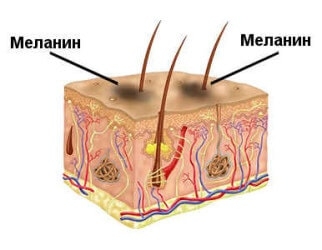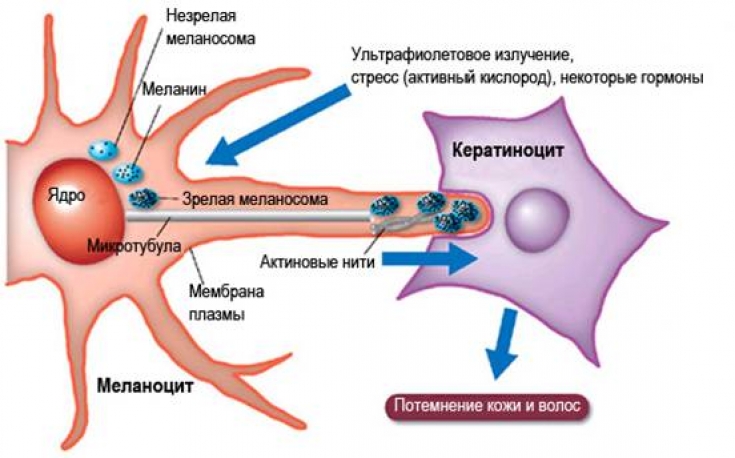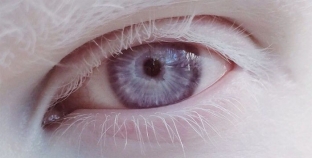As a barrier to the aggressive influence of the environment, the skin has in its arsenal more than one means to neutralize the enemy. And the first enemy – this is ultraviolet light. Sunburn is a direct result of the activation of the body's defenses and the work of melanocytes, which produce the natural pigment – melanin.
The color of skin, eyes and hair is determined by the level of melanin in the epidermis. As two in one: pigment coloring and protecting the body. Melanin in the body is able to activate many biological processes. Read about the synthesis of melanin in the body and its functions in this article.
What is melanin and why is it important
Melanin is a suspension of polymer compounds that color living tissues (human, animal, fungi, microorganisms). The general concept of "melanin" combines several types of similar compounds: DOPA (black, brown), pheomelanins (yellow), neuromelanins. In the human body, only DOPA-melanins function widely. Melanins of the DOPA class cannot dissolve in water, acids or solvents. But, they become sensitive in an alkaline environment.
Settles in the epidermis, melanin is formed in melanocytes, which are located in the basal layer of the skin. Melanocytes are located under a layer of keratinocytes and are stored in the form of granules, inside which the pigment is combined with protein. There are approximately 1200 melanocytes per 1 cm2 of the skin, which are connected to keratinocytes by special bridges – desmosomes. Through these bridges, melanin rises to its destination: in the upper layers of the skin, hair roots, iris.

How it happens:
From the processes of the melanocyte, the melanin pigment moves to the keratinocytes along the bridge through the process of phagocytosis. In keratinocytes, melanin binds to protein and accumulates. Thus, the color of the skin, eyes, hair is determined. There are 40 keratinocytes per 1 epidermal-melanin unit and only 1 melanocyte. The level of melanin determines the color, therefore, in people of light races, the epidermis contains single granules with pigment. In people of the Negroid race, the epidermis is completely filled with granules with pigment. When the sun is active, the body needs constant protection, so melanocytes constantly produce melanin, regardless of the season.
Read also: Pigmentation and hormones: why spots appear on the face
How melanin is synthesized in the body
So, some chemistry. Melanin is produced in the body under the guidance of hormones secreted by the pituitary gland – melanocyte-stimulating hormones. Melanin is synthesized in melanosomes (melanocyte organelles). First, the amino acid tyrosine is oxidized, as a result of this chemical process, DOPA is produced amino acid – dihydroxyphenylalanine (precursor of adrenaline). After further oxidation of the DOPA molecule, it is converted into melanin. The pigment accumulates in the epidermis and is activated by the action of sunlight, covering the body with a tan.
Why does the body need melanin: the benefits of the pigment
The main task of melanin – Protection of body cells from the damaging effects of ultraviolet radiation. Melanin acts as a screen, reflecting more rays, and as an absorbent component that collects those rays that could penetrate the epidermis. The sun's rays absorbed by melanin do not disappear anywhere, they are partially processed into heat, and the remnants of the rays – for reserve to provide photochemical reactions.
Melanin protects the cell nucleus from loss and deformation of genetic information under the influence of the sun. Located in the very center, melanin acts as a DNA security system.

Melanin functions:
- neutralize free radicals;
- accelerate chemical and biological reactions in the body;
- relieve stress;
- provide an adaptogenic effect;
- water-soluble melanin is able to perform a transport function;
- neutralize pathogenic changes in the thyroid gland, hypothalamus, adrenal glands, liver.
How hair and eyes are dyed
DOPA melanin penetrates deep into the hair and gives it a dark shade. If there are few pigment granules in the hairs and they are located on the surface, the hair color will be light.
It is interesting that in red-haired people, melanin is not granular, but diffuse.
The color of the eyes depends on the level and depth of the melanin. The presence of melanin in the 4th or 5th layer determines the blue or cyan color. If the pigment is located in the upper layers of the iris, then the eyes will be brown or light brown. In the case of a chaotic arrangement of melanin in the layers of the iris, the eyes may be gray or green.
What is albinism
When melanin is produced in the body in small quantities or it is not produced at all, albinos are born – people with white hair, eyes, and almost colorless white skin. In addition to their distinctive appearance, such people suffer from vision and hearing problems, cannot be in the sun, and have too low immunity.
It is interesting that melanin can be produced not only in limited quantities, but also in excess. In this case, melanosis develops.

Read also: White spots on the skin: what is hypomelanosis
Thus, the synthesis of melanin in the body is important for the full functioning of many systems. Without it, immunity is depleted, because many pathogenic substances penetrate through the skin that can harm cells and lead to irreversible degradation and destruction of fibers, and, accordingly, of the whole organism as a whole.
Be more in the sun, recharge with positive emotions and increase your immunity with estet-portal.com.






Add a comment